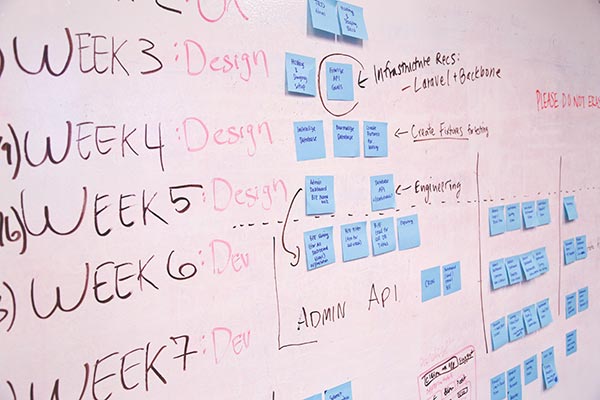It’s happened to everyone: You’re in the middle of a project, and suddenly a problem emerges—one you didn’t anticipate but one that needs to be resolved right away. From small updates to complete overhauls, changes in a project can be costly. But what if you anticipated modifications before the project even began?
Fortunately, agile methodologies allow you to not only respond to change but to also learn from the experience—as well as better collaborate with clients and create the best solutions.
What are agile methodologies?
Agile is a mindset that empowers teams to adapt and react to change efficiently through repeated testing and development. Projects rarely go as planned, and a flexible approach can greatly improve the end product. Agile allows for revision throughout the project, accommodates new ideas and discoveries, and increases communication among participants. These revisions help shorten the feedback cycle for and allow more time to react to issues.
History of agile
In 2001, 17 software developers came together with the goal of "uncovering better ways of developing software by doing it and helping others do it," and published The Agile Manifesto. As technology evolved, developers had realized the traditional “waterfall” method of meeting customer demands was not an effective or sustainable approach. The group met to discuss the various ways they planned and resolved projects. Together, they created a set of four values and 12 principles, which are now used by teams large and small across countless industries.
The four values include:1. Individuals and team interactions over processes and tools2. Working software over comprehensive documentation3. Customer collaboration over contract negotiation4. Responding to change over following a plan
How does it work?
Over the ensuing years, agile has become an umbrella term for various strategies. The popularity of these “frameworks” is usually determined by industry and team size. Although there’s some debate about what processes qualify as “agile,” most agree that any process in line with the values and principles can be considered agile. In fact, some of the most well-known frameworks include test-driven development (TDD), behavior-driven development (BDD), dynamic systems development method (DSDM), extreme programming (XP), Kanban and Scrum.
Each framework has its own key players, but the process usually begins by gathering a team and establishing a set of agile practices to complete a specific project. The project is broken down into phases, and each team member contributes to the overall success of the project.
Teams meet at least once a day to report progress and next steps. Frequent and open communication keeps the entire team on the same page and prevents knowledge silos. Unlike the waterfall methodology, each team member continually tests their progress to check for any issues or potential setbacks, and constant communication is necessary to move a project forward.
However, the communication and evaluation don’t end once a project is complete. After each iteration, the team meets to review issues, setbacks and lessons learned. These meetings, called retrospectives, allow each member of the team to evaluate the good and bad of the project and provide suggestions for improvement.
The benefits of agile
Allowing modifications throughout a project has many benefits. Continual testing ensures the success of a product and can expose future vulnerabilities so teams are prepared for potential issues.
Frequent and open communication with the client through the project reduces the likelihood of a product failing to meet the standards or needs of the consumer. Clients are free to make suggestions and work as part of a team, which can reduce the number of adjustments needed once a project is already complete.
Overall, agile practices encourage communication, collaboration and growth. Each team member is trusted to complete their task and improve their assignment based on testing and feedback. Although team members work individually, everyone works toward a common goal. From startups to large corporations, companies of any size can benefit from the flexibility offered from an agile approach.
It’s important to keep user experience in mind for any project, and practicing an agile methodology can help you meet your clients’ needs. Utilizing agile frameworks can increase collaboration, cultivate trust and help your company achieve long-term success through testing for errors and responding to feedback.
Are you interested in using an agile framework? At Binary Noggin, we use agile methodologies to develop tailored, flexible solutions and serve as a trusted extension of your team. Contact us today to learn more how you can introduce strategies to make the software development process more effective for your company.
Amos King is the founder and CEO of Binary Noggin. In addition to attending and serving as keynote speaker at conferences like ElixirConf and Lonestar Elixir, Amos is a co-host of the popular Elixir Outlaws and This Agile Life podcasts.
Founded in 2007, Binary Noggin is a team of software engineers and architects who serve as a trusted extension of your team, helping your company succeed through collaboration. We forge customizable solutions using Agile methodologies and our mastery of Elixir, Ruby and other open source technologies. Share your ideas with us on Facebook and Twitter.

